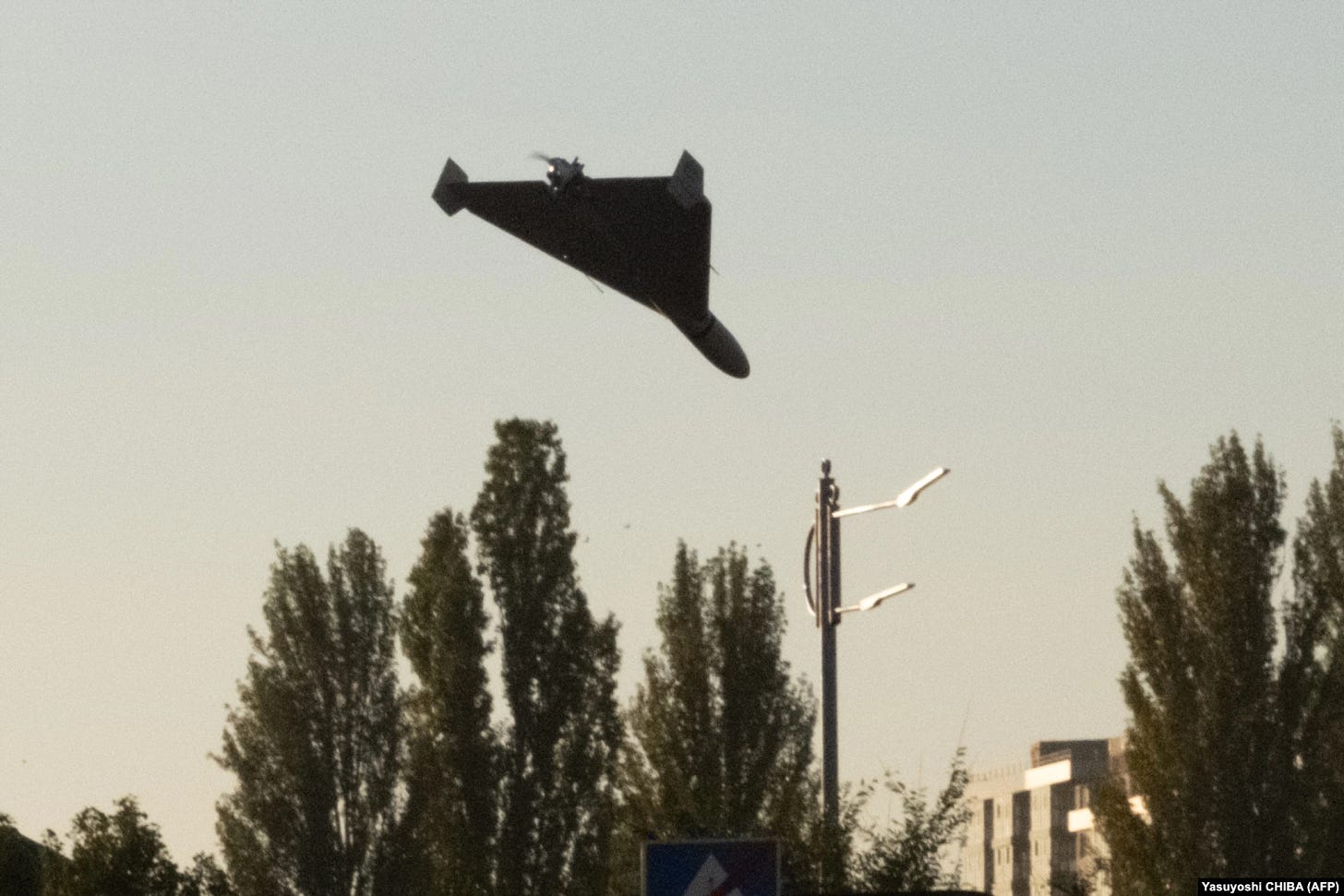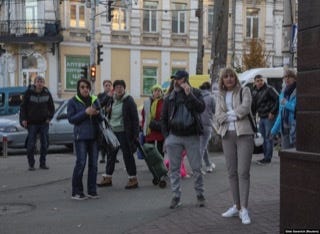US: Iran "now directly engaged" in Russian war on Ukraine through drone shipments, military trainers in Crimea
The US, EU and UK announced actions today (October 20) targeting Iran’s supply of armed drones to Russia being used to attack Ukrainian civilians and civilian infrastructure.

The United States, European Union and United Kingdom all announced actions today targeting Iran’s provision of armed drones to Russia being used to attack Ukrainian civilians and civilian infrastructure.
Iranian military trainers and technical support personnel have been on the ground in Russian-occupied Crimea assisting Russian forces in their use of Iranian-supplied unmanned aerial vehicles (UAVs) to conduct strikes on civilian and military targets in Ukraine, the U.S. National Security Council said today.
“Today, we can confirm that Russian military personnel that are based in Crimea have been piloting Iranian UAVs…to conduct strikes across Ukraine, including strikes against Kyiv just in recent days,” National Security Council strategic communications coordinator John Kirby told journalists in a virtual briefing today (Oct. 20). “We assess that Iranian military personnel were on the ground in Crimea and assisted Russia in these operations.”
Russians are piloting the drones, but the Iranians have put trainers and technical support personnel in Crimea to train them how to use the weapons systems, which were not initially performing well, in part because the Russian military does not have experience using them, Kirby said.
The comments came after a closed-door meeting at the UN Security Council Wednesday evening in which experts briefed the body on the matter. The US, UK, France and Ukraine say the provision of the Iranian attack drones over the 300km range to Russia is a violation of UN Security Council resolution 2231 (UNSCR 2231), that was passed after the reaching of the 2015 Iran nuclear deal.
The resolution has an Annex B, that links to a list of missile control technology regime items that cannot go to or from Iran without getting explicit permission from the Security Council. That list of controlled and prohibited items includes UAVs with a range of over 300km, which the Iranian Shahed 136 UAV, sometimes called the kamikaze drone, does.
“Clear violation of UNSCR 2231,” a European diplomat said before the UN meeting.
“It’s unambiguous,” a senior US administration official, speaking not for attribution, told me Wednesday after the meeting. He said that the Ukrainians have reported the use of the Iranian drones by Russia to attack Ukrainian territory to the 2231 committee as a violation. Experts who work for the UN Secretariat will investigate the claims of the violation, and report back to the UN Security Council.
A Russian UN representative claimed, seemingly without much conviction, that the UAVs being used by the Russian army in Ukraine were Russian-manufactured, and said the UN did not have a mandate to investigate the matter. Any UN investigation would force Russia to consider cutting off cooperation with the world body, he said.
“These are all baseless allegations,” Russian deputy ambassador to the UN Dmitry Polyanskiy said after the meeting Wednesday, reading from notes.
“Truly moronic logic from one of the most disgusting persons the UN has ever seen,” an outraged Ukrainian envoy Sergiy Kyslytsya shot back on Twitter. “Russia will reassess cooperation with [UN Secretary General] Antonio Guterres if he sends experts to Ukraine to inspect drones that were apparently made in Iran and used in violation of a UN resolution to kill civilians.”
The NSC’s Kirby said Russia and Iran can try to lie about the matter, but the facts are clear.
“There is extensive proof of their use by Russia against both military and civilian targets there,” Kirby said of the Iranian drones. “Yet both Iran and Russia continue to lie about it.”
“The fact is this: Tehran is now directly engaged on the ground, and through the provision of weapons that are impacting civilians and civilian infrastructure in Ukraine,” Kirby said. “In fact, that are killing civilians and destroying civilian infrastructure in Ukraine.
“So let's be very clear: the United States is going to pursue all means to expose, deter and confront Iran's provision of these munitions against the Ukrainian people,” Kirby said. “We're going to continue to vigorously enforce all US sanctions on both the Russian and Iranian arms trade. We're going to make it harder for Iran to sell these weapons to Russia. We're going to help the Ukrainians have what they need to defend themselves against these threats.”
Kirby said that Russia had received “dozens” of Iranian UAVs so far, “and will likely continue to receive additional shipments in the future.” Given Russia’s ongoing supply shortages, the U.S. is also concerned that Russia may seek to acquire other advanced weapons from Iran, such as surface to surface missiles, he said.
Fig-leaf of deniability
Regarding Russian and Iranian faint protestations, Iran analyst Henry Rome said they are just deflecting, and did not seem intent on really trying to convince anybody.
“I think Russia does not want to get up there on the parapet and scream that they are having to rely on Iranian drones for their operations,” Rome, with the Washington Institute for Near East Policy, said in an interview. “And I think preserving some fig-leaf of deniability is probably important for the Iranians as well.”
“Claims made regarding the Islamic Republic sending weapons including military drones to be used in the Ukraine war” are “untrue,” the Iranian Ministry of Foreign Affairs said in a statement on Oct. 18.
‘Left of launch’
UAV expert Samuel Bendett said the most effective way to counter the Iranian drones in the Ukraine war theater was what he called “left of launch,” before the weapons had made it onto the field.
“I think the biggest, most effective way to stop any type of military action is left of launch,” Bendett, with the CNA think tank, said in an interview. But when they are already in the field, he said, the combined effects of “military pressure, economic pressure, industrial pressure, sanctions pressure…can in fact impact how a nation behaves in the end.”
Bendett said open source intelligence sources have tracked at least 40 Iranian flights and cargo aircraft traveling to Russia from Iran via the Caspian Sea since the summer. “They were obviously bringing something there.”
The United States first publicly said in July that Iran and Russia had been in discussions about the provision of Iranian drones to Russia for use in Ukraine.
Before the NSC’s Kirby had confirmed the presence of Iranian military personnel in Crimea today, Bendett said it would not surprise him to learn that Iran had technicians in Crimea to support the package. “Russians don’t have experience flying loitering drones” at the distance the Iranian UAVs have, he said. So it would make sense the Iranians “would need teach the Russians how to use these.”
He said Ukraine also has a number of technologies to counter the Iranian drones, which are loud—giving rise to their being dubbed flying lawnmowers.
“Ukraine has been able to interdict most of these drones,” he said. But the Russians’ recent use of them to go after Ukrainian civilian targets has contributed to the destruction of an estimated 30% of Ukraine’s energy infrastructure, as well as killed Ukrainian civilians, including a pregnant woman in Kyiv this week.
“Russian military doctrine places the enemy’s economic and civilian infrastructure as at the same level as military targets,” Bendett said. “They don’t just go after military targets, but go after the other side’s civilian infrastructure.”
They aim to sap the morale of the Ukrainian civilian population to continue to defend their country from Russia’s invasion, he said. So far, it hasn’t worked, but the big question is, if this continues for months, if people would feel the same way.

UK: Iran’s support for Putin war deplorable
The European Union and UK today announced sanctions on the Iranian company that makes Iran’s Shahed drones, Shahed Aviation Industries, and three Iranian military officials they charged with being involved with the supply of Iranian drones to Russia.
“Iran’s support for Putin’s brutal and illegal war against Ukraine is deplorable,” British Foreign Secretary James Cleverly said in the statement Oct. 20. “These cowardly drone strikes are an act of desperation.”
“The Iranian regime provides military support for Russia’s unprovoked and unjustified war of aggression against Ukraine,” the European Union council said in a notice of the new sanctions designations.
The Russians in Ukraine have been launching the Iranian Shahed 136 drones “in waves,” said John Krzyzaniak, a research associate working on Iran with the Wisconsin Project on Nuclear Arms Control. While most are shot down, others make it through.
He noticed that until now, the US, oddly, had not sanctioned the manufacturer of the drones, Shahed Aviation Industries, although it had sanctioned its parent company.
U.S. officials suggested more actions are coming.
“We have said…that, nuclear deal or not, we are going to continue to use the tools we have to deter, confront and contain other concerns we have with Iran,” the senior US administration official said. “So we are going to do that with these arms shipments.”
“We have already designated a number of entities for sanctions…and we have got more in the works,” he said. “We have done some Commerce Department actions which complicate the logistics of the air deliveries.”
“You could anticipate more along these lines,” he said, “and more of the U.S. revealing to the world what the Iranians are doing, often before they do it.”
**


